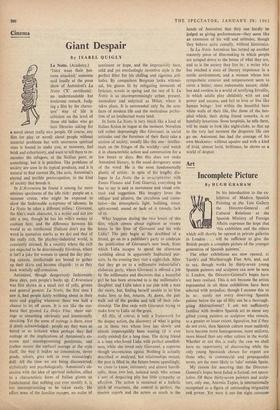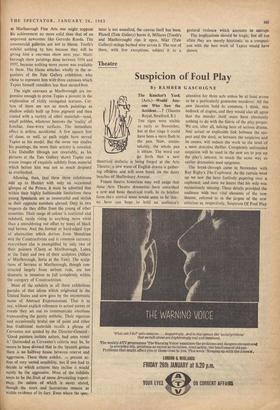Art
Incomplete Picture
By HUGH GRAHAM
IN his introduction to the ex- hibition of Modern Spanish Painting at the Tate Gallery The other exhibitions are now opened, at Tooth's and Marlborough Fine Arts, and, sad to say, though works by thirty-seven young Spanish painters and sculptors can now be seen in London, the Director-General's hopes have not been realised. This is not because the artists represented in all three exhibitions have been selected with prejudice, though I assume this to be so: surely not every deserving Spanish painter below the age of fifty can be a thorough- going Abstractionist? I am not sufficiently familiar with modern Spanish art to name any gifted young painters or sculptors who remain, to a greater or lesser extent, figurative, but if they do not exist, then Spanish culture must suddenly have become more homogeneous, more uniform, more biased than any other culture in the world. Whether or not this is really the case we shall have no opportunity of discovering while the only young Spaniards chosen for export are 'those who, in commercial and propagandist terms, are the most likely to 'take' outside Spain.
My reason for asserting that the Director- General's hopes have failed is factual, not specu- lative. Of these thirty-seven painters and sculp- tors, only one, Antonio Tapies, is internationally recognised as a figure of outstanding originality and power. Yet were it not for eight canvases at Marlborough Fine Arts one might suppose his achievement no more solid than that of an unproved newcomer like Gerardo Rueda. The commercial galleries are not to blame. Tooth's exhibit nothing by him because they will be giving him a one-man show next year. Marl- borough show paintings done between '1954 and 1957, because nothing more recent was available to them. The blame attaches wholly to the or- ganisers of the Tate Gallery exhibition, who chose to represent him with-three canvases which Tapies himself considers less than second-best.
The eight canvases at Marlborough are im- pressive enough to prove Tapies a pioneer in the exploration of richly variegated textures. Cer- tain of them are not so much paintings as shallow reliefs built up from pigment and then coated with a variety of other materials—sand, small pebbles, whatever bestows the 'reality' of familiar, time-worn surfaces. The immediate effect is artless, accidental. A few square feet of dune, or wall, or path might have served Tapies as his model. But the more one studies his paintings, the more their artistry is revealed. Like Dubuffet (though not invariably, as his pictures at the Tate Gallery show) Tapies can create images of exquisite subtlety from material which before him was not so much despised as overlooked.
Allowing, then, that these three exhibitions add up to Hamlet with only an occasional glimpse of the Prince, it must be admitted that within their highly fashionable limitations these young Spaniards are as resourceful and stylish as their opposite numbers abroad. Only in two respects do they differ from the young of other countries. Their range of colour is restricted and subdued, rarely rising to anything more vivid than a smouldering red offset by tones of black and brown. And the formal or hard-edged type of abstraction which derives from Mondrian and the Constructivists and is common currency everywhere else is exemplified by only two of their painters (Claret at Marlborough, Labra at the Tate) and two of their sculptors (Alfaro at Marlborough, Soria at the Tate). The sculp- tures of Serrano at Marlborough, though con- structed largely from unbent rods, are too dramatic in intention to fall completely within the category of Constructivism.
Most of the exhibits in all three exhibitions partake of that idiom which originated in the United States and now goes by the oxymoronic name of Abstract Expressionism. That is to say, without explicit reference to actual scenes or events they set out to communicate emotions transcending the purely aesthetic. Their vigorous and occasionally brutal use of paint and other less traditional materials recalls a phrase of Cervantes not quoted by the Director-General: `Good painters imitate nature, bad ones vomit it.' Outmoded as Cervantes's criteria may be, he seems to have divined that in the Spanish genius there is no halfway house between reserve and aggression. These three exhibif. present ar- tists of very varied sensibility, but if one had to decide to which extreme they incline it would surely be the aggressive. Most of the exhibits seem to be the fruit of some devastating experi- ence, the nature of which is never stated, though the scars and lacerations remain as visible evidence of its fury. Even where the spec- tator is not assaulted, the canvas itself has been. Planell (Tate Gallery) burns it, Millares (Tooth's and Marlborough) rips it open, Mier (Tate Gallery) strings barbed wire across it. The rest of them, with few exceptions, subject it to a gestural violence which amounts to outrage.
The implications should be tragic, but all toe often they are merely histrionic, as a compari- son with the best work of Tapies would have shown.







































 Previous page
Previous page